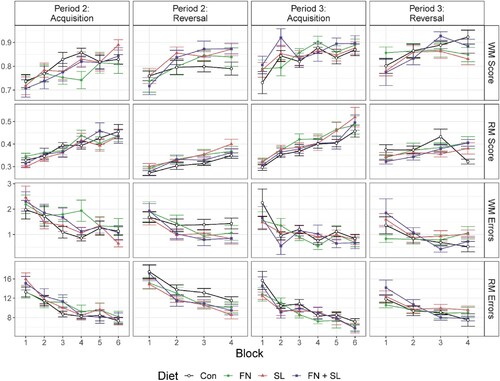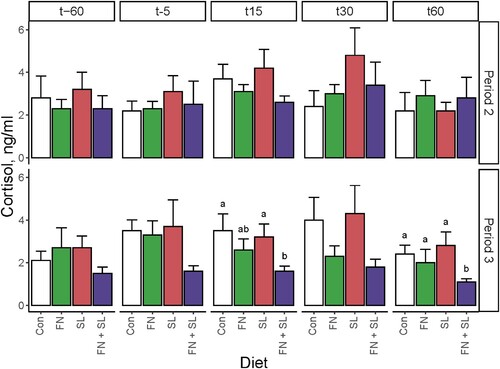Figures & data
Figure 1. Schematic depicting the study design. In total, 64 female pigs born from 20 sows were subjected to a series of behavioral tests during a period of early development, shortly before sexual maturity, and at sexual maturity [Citation33]. The study was conducted over 3 cohorts, with 2-week intervals between cohorts. During the first week of age, pigs were kept with the sows and housed in individual farrowing pens. At 2 weeks of age, formula-fed pigs were separated from sows and housed in mixed groups of 2 pigs per pen. In addition, 8 pigs were cross-fostered and kept with 3 sows until the end of the milk intervention at 10–11 weeks of age (termed the Sow-Reared (SR) group). After being weaned from maternal milk at 10–11 weeks of age, SR pigs were housed in the same conditions as the formula-fed pigs. At 2 weeks of age, formula-fed pigs were randomly allocated to 1 of 4 milk formulas, enriched with a different oligosaccharide mixture, up to 11 weeks postnatal. After weaning at 10–11 weeks of age, formula-fed and SR pigs were fed a high-energy, obesogenic diet. Generally, the sample size was n = 12 pigs for each group, with n = 8 in the SR group. Pigs were tested on a variety of behavioral tasks designed to assess anxiety, motivation, appetite, learning, and memory.
![Figure 1. Schematic depicting the study design. In total, 64 female pigs born from 20 sows were subjected to a series of behavioral tests during a period of early development, shortly before sexual maturity, and at sexual maturity [Citation33]. The study was conducted over 3 cohorts, with 2-week intervals between cohorts. During the first week of age, pigs were kept with the sows and housed in individual farrowing pens. At 2 weeks of age, formula-fed pigs were separated from sows and housed in mixed groups of 2 pigs per pen. In addition, 8 pigs were cross-fostered and kept with 3 sows until the end of the milk intervention at 10–11 weeks of age (termed the Sow-Reared (SR) group). After being weaned from maternal milk at 10–11 weeks of age, SR pigs were housed in the same conditions as the formula-fed pigs. At 2 weeks of age, formula-fed pigs were randomly allocated to 1 of 4 milk formulas, enriched with a different oligosaccharide mixture, up to 11 weeks postnatal. After weaning at 10–11 weeks of age, formula-fed and SR pigs were fed a high-energy, obesogenic diet. Generally, the sample size was n = 12 pigs for each group, with n = 8 in the SR group. Pigs were tested on a variety of behavioral tasks designed to assess anxiety, motivation, appetite, learning, and memory.](/cms/asset/81684cfb-beb8-41e0-ae3b-f31aa5f593fb/ynns_a_1975877_f0001_ob.jpg)
Table 1. Ingredient composition of milk replacers.
Table 2. Macronutrient composition of the base diets.
Figure 2. Growth and intake data. Across the trial, there were no differences in bodyweight growth between groups (P < 0.05). A lean reference using Göttingen minipigs from the vendor (Ellegaard) is shown to verify the weight-gain inducing capacity of the diets used. Milk and feed intake were measured per pen (2 animals per pen). Milk replacer was provided at 325 mL/kg BW per day and pelleted feed was fed twice per day. Variation in milk intake was observed during Periods 1 and 2, however by Period 3 feed intake was equivalent between groups as all pigs consumed the pelleted feed provided.

Figure 3. Average performance by training block on select variables in the holeboard task. Data represent an average of 4 trials within each block. By block, animals in all groups improved both their working memory (WM) and reference memory (RM) scores, while errors decreased. As expected, reversal trials lowered performance which quickly recovered in subsequent blocks. Performance during Period 1 was considered ‘training’ as most groups demonstrated poor behavior, thus is not shown. Data were analyzed via one-way ANOVA sliced by time with diet, cohort, and blocks as main effects (shown in ). Abbreviations: Con, control group; FN, group fed fucosylated and neutral oligosaccharides; SL, group fed sialylated oligosaccharides; FN + SL, group fed both FN and SL.

Figure 4. Average performance on select variables in the holeboard task. Averaged over blocks, the SL group demonstrated greater reference memory (RM) scores and fewer errors (P < 0.05) on the reversal phase at Period 2. The Control group demonstrated the shortest inter-visit interval (IVI) at all times measured, and also completed the trial faster during acquisition and reversal trials of Periods 2 and 3, respectively (P < 0.05). Data were analyzed via one-way ANOVA sliced by time with diet and cohort as main effects with a post-hoc Tukey adjustment for multiple pairwise comparisons. Abbreviations: Con, control group; FN, group fed fucosylated and neutral oligosaccharides; SL, group fed sialylated oligosaccharides; FN + SL, group fed both FN and SL.

Figure 5. Observed behavior during the Open Field and Novel Object tasks. Behaviors were characterized by % time spent in various postures, exploratory behaviors, and frequency of discrete events. See Supplemental Table 4 for a detailed description. Due to great variability, at no point did any group demonstrate behavior different from another. Data were analyzed via one-way ANOVA sliced by time with diet and cohort as main effects. Abbreviations: Con, control group; FN, group fed fucosylated and neutral oligosaccharides; SL, group fed sialylated oligosaccharides; FN + SL, group fed both FN and SL.

Figure 6. Salivary cortisol before and after Open Field testing. Saliva samples were collected from each pig in the home pen at 60 before (t-60), 5–10 min before (t-5), and 15, 30, and 60 min after the pig entered the test arena (t15, t30, and t60, respectively). In general, salivary cortisol exhibited high variability between and within-groups. At Period 2, there were no differences between groups. During Period 3, the FN + SL group displayed the lowest salivary cortisol at all times; this was only significantly different from other groups at t15 and t60. Data were analyzed via one-way ANOVA sliced by time with diet and cohort as main effects with a post-hoc Tukey adjustment for multiple pairwise comparisons. Abbreviations: Con, control group; FN, group fed fucosylated and neutral oligosaccharides; SL, group fed sialylated oligosaccharides; FN + SL, group fed both FN and SL.

Supplemental Material
Download Zip (381.8 KB)Data availability statement
Data may be made available upon request.
